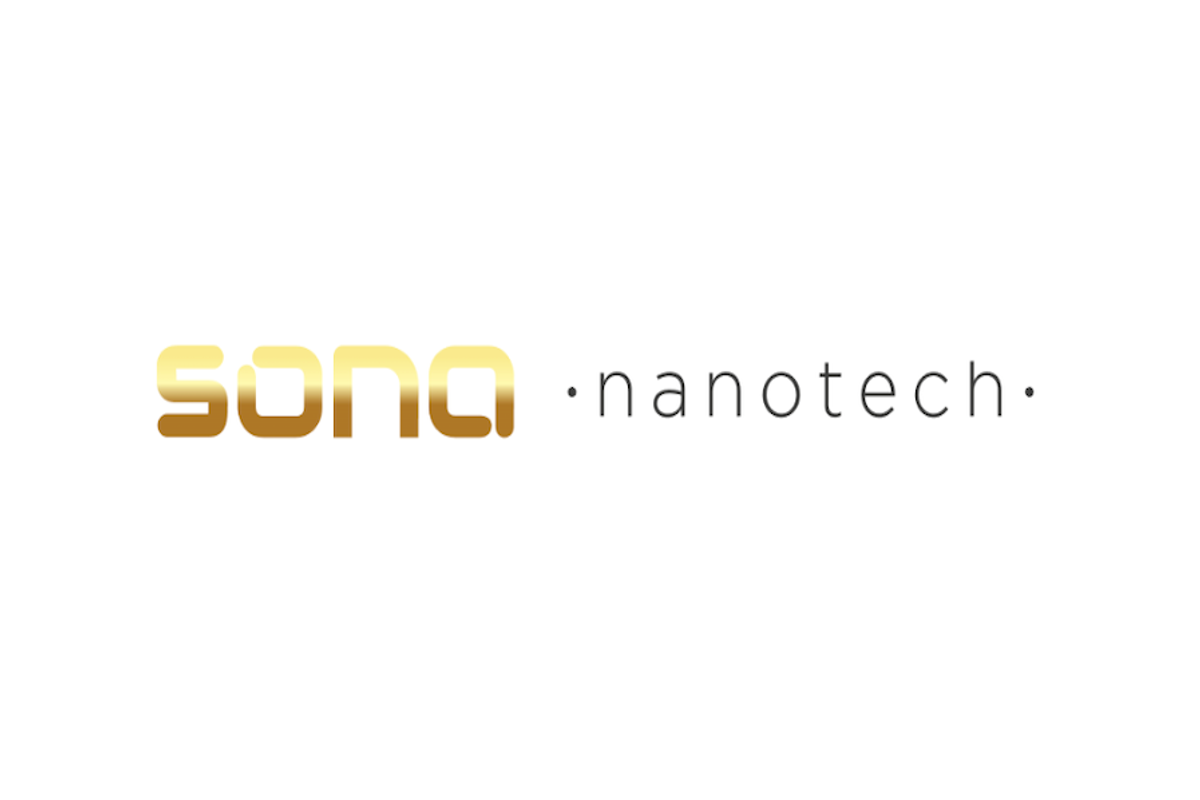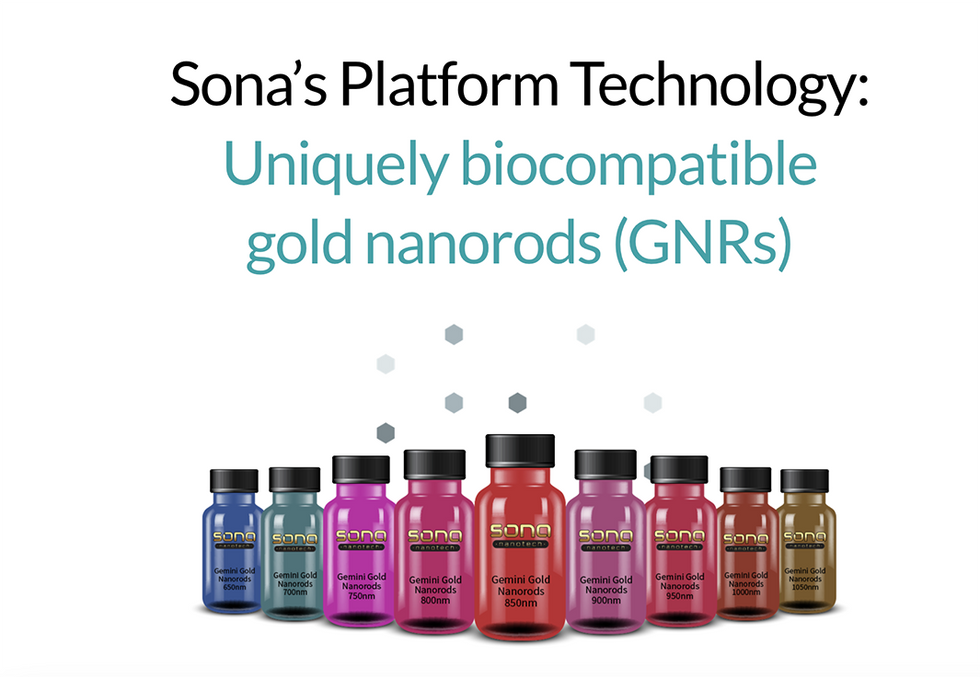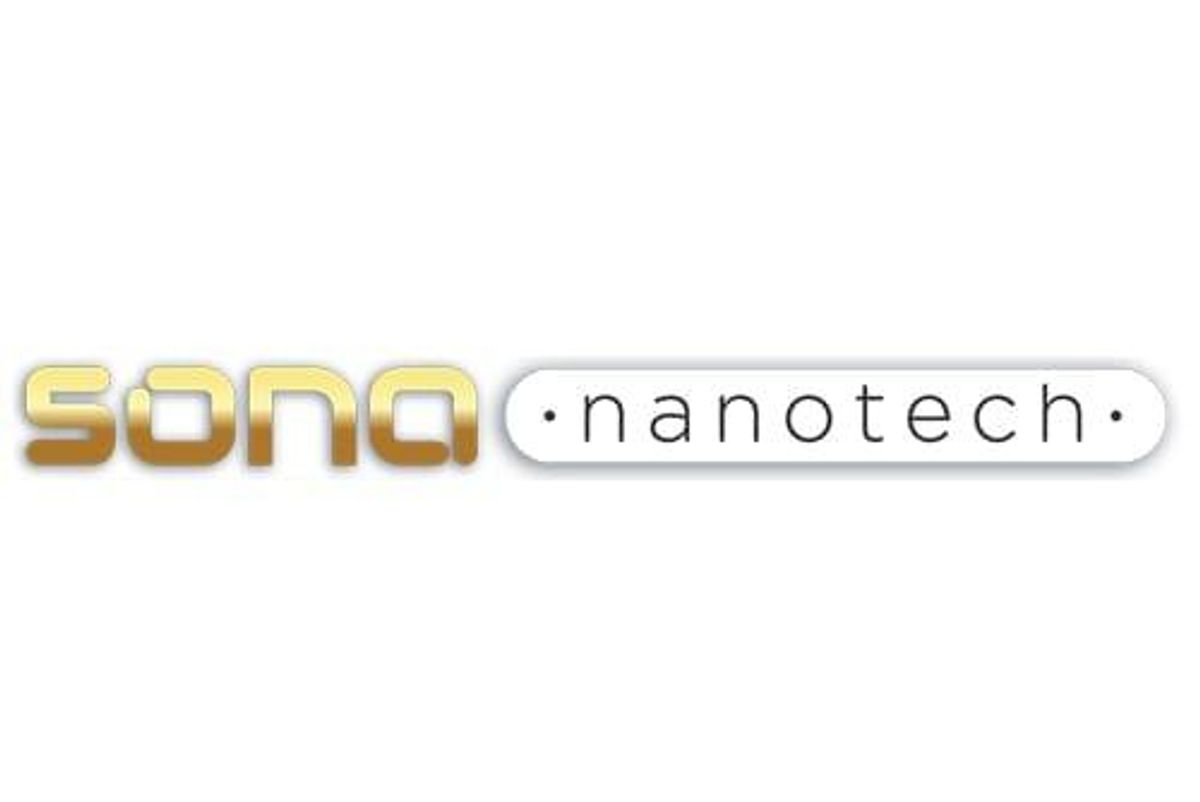
October 17, 2023
Sona Nanotech (CSE:SONA, OTCQB:SNANF) advances nanotechnology medicine through its proprietary gold nanorods that promise to change the face of cancer therapy. Sona Nanotech's platform technology leverages uniquely biocompatible gold nanorods (GNRs). Biocompatibility is key to the application of nanotechnology in medicine.
For the past several years, Sona has been working hard to develop and operationalize its biocompatible nanoparticle technology for use in targeted cancer therapy. The company is also developing a targeted cancer therapy, leveraging its proprietary Targeted Hyperthermia Therapy (THT) to directly treat cancer cells.

Sona's GNRs are rod-shaped nanoparticles made of gold and measuring from 10 to 100 nanometers in length. Produced by chemical synthesis, they directly address many of the current limitations of medical nanoparticle technologies. In addition to making them well-suited for cancer treatment, this also unlocks their potential for use in in-vivo medical applications.
Company Highlights
- Canadian nanotechnology company, Sona Nanotech has developed an incredibly promising new technology that leverages uniquely biocompatible gold nanorods.
- The company also plays a key role in the advancement of photothermal medical therapies, particularly enabled by the company's acquisition of Siva Therapeutics.
- This acquisition has allowed Sona to advance the development of Targeted Hypothermia Therapy, addressing many of the risks with current cancer treatments — particularly the damage they can cause to other tissues.
- THT has already proven effective in reducing tumors in small animal studies. Sona's initial target for the technology will be colorectal cancer.
- Rapid diagnostic tests represent the company's other strategic area of focus, including bovine tuberculosis detection and concussion screening.
- Future applications for Sona's technology could include:
- Targeted drug delivery
- Photothermal cosmetic therapy
- Cell imaging
- Additional proprietary testing solutions supported by third-party test development services.
- The company's leadership and board of directors comprise experienced professionals from across the healthcare and biotechnology sectors.
- Sona has a clear roadmap to commercialization of its treatment methodology, starting with a near-term catalyst in large animal studies before moving to a human pilot. It also expects a De Novo pathway for medical devices.
This Sona Nanotech is part of a paid investor education campaign.*
Click here to connect with Sona Nanotech (CSE:SONA) to receive an Investor Presentation
SONA:CNX
The Conversation (0)
27 June 2024
Sona Nanotech
Advancing breakthrough cancer therapy through nanotechnology
Advancing breakthrough cancer therapy through nanotechnology Keep Reading...
12 February
Sona Nanotech's Targeted Hyperthermia Therapy To Be Presented at the International 19th Canadian Melanoma Conference
Sona Nanotech Inc. (CSE: SONA) (OTCQB: SNANF) (the "Company", "Sona") is pleased to announce that its recently published findings from its "Targeted Intra-tumoral Hyperthermia with Uniquely Biocompatible Gold Nanorods Induces a Strong Immunogenic Cell Death in Two Immunogenically 'Cold' Tumors"... Keep Reading...
13 January
Sona Nanotech's THT Cancer Therapy Preclinical Efficacy Studies Published In Peer-Reviewed Scientific Journal
Sona Nanotech Inc. (CSE: SONA) (OTCQB: SNANF) (the "Company", "Sona") is pleased to announce that the now complete findings from our previously announced pre-clinical breast cancer and melanoma efficacy studies have been published in the peer-reviewed scientific journal, Frontiers in Immunology.... Keep Reading...
11 December 2024
Sona Nanotech's THT Cancer Studies Demonstrates Strong Efficacy in Third Preclinical Study and Plans for First-in-human Early Feasibility Study
Sona Nanotech Inc. (CSE: SONA) (OTCQB: SNANF) (the "Company", "Sona") announces results from its most recent preclinical study of its Targeted Hyperthermia Therapy ("THT") which uses the Company's patented, biocompatible gold nanorods ("GNRs") to treat certain solid cancer tumors, shrinking them... Keep Reading...
07 November 2024
Sona Nanotech to Showcase Its THT Cancer Therapy at NCL 20th Anniversary Symposium and Provides Corporate Update
Sona Nanotech Inc. (CSE: SONA) (OTCQB: SNANF) (the "Company", "Sona") is pleased to announce that its Chief Scientific Officer, Dr. Len Pagliaro, has been invited to showcase Sona's developing Targeted Hyperthermia Therapy ("THT") cancer treatment today at the Nanotechnology Characterization... Keep Reading...
21 October 2024
Sona Nanotech Issued Patent and Appoints New Board Member
Sona Nanotech Inc. (CSE: SONA) (OTCQB: SNANF) (the "Company", "Sona") is pleased to announce the issuance of U.S. Patent No. 12117447 by the U.S. Patent and Trademark Office to the Company, entitled, "Metal Nanoparticles and Methods of Making Same". This patent covers the Company's proprietary... Keep Reading...
09 October 2024
Sona Nanotech Grants Options
Sona Nanotech Inc. (CSE: SONA) (OTCQB: SNANF) (the "Company" or "Sona") is pleased to announce that it has granted 25,000 incentive stock options under the Company's Stock Option Plan ("Option Plan") to a consultant. Each option is exercisable into one common share at a price of $0.30 per share... Keep Reading...
10 June 2024
Longeveron to Present at the Emerging Growth Virtual Conference on June 12, 2024
Longeveron Inc. (NASDAQ: LGVN), a clinical stage biotechnology company developing regenerative medicines, today announced that it will participate in the Emerging Growth Virtual Conference taking place June 12-13, 2024. Details for the Company's presentation: Date: Wednesday, June 12, 2024 Time:... Keep Reading...
10 June 2024
Veru to Present at the American Diabetes Association's 84th Scientific Sessions
Veru Inc. (NASDAQ: VERU), a late clinical stage biopharmaceutical company focused on developing innovative medicines for preserving muscle for high quality weight loss, oncology, and viral induced acute respiratory distress syndrome, today announced that the Company will present two... Keep Reading...
06 June 2024
Dr. Giovanni Selvaggi, Who Has Brought Several Oncology Drugs to Market, Joins CEL-SCI as Clinical Advisor
Dr. Selvaggi was instrumental in the development and approval of lung cancer drugs Zykadia for Novartis and Opdivo for Bristol Myers Squibb CEL-SCI's Multikine immunotherapy improves the 5-year survival of head and neck cancer patients to 73% compared to 45% in controls and cuts the 5-year risk... Keep Reading...
05 June 2024
Ventyx Biosciences Announces Positive Preclinical Data for CNS-Penetrant NLRP3 Inhibitor VTX3232 Demonstrating Reversal of Obesity and Improvements in Cardiometabolic and Inflammatory Markers
VTX3232 demonstrated improvements in body weight, systemic inflammatory biomarkers and cardiometabolic parameters in diet-induced obesity (DIO) mice Additive effects were observed for VTX3232 in combination with the GLP-1 receptor agonist semaglutide across key endpoints compared to semaglutide... Keep Reading...
03 June 2024
Longeveron® Announces Contract Development and Manufacturing Business and First Contract
Contract manufacturing services as a new business line has the potential to generate approximately $4-5 million in annual revenues First manufacturing services contract signed with Secretome Therapeutics Longeveron Inc. (NASDAQ: LGVN), a clinical stage regenerative medicine biotechnology company... Keep Reading...
Latest News
Interactive Chart
Latest Press Releases
Related News
TOP STOCKS
American Battery4.030.24
Aion Therapeutic0.10-0.01
Cybin Corp2.140.00

